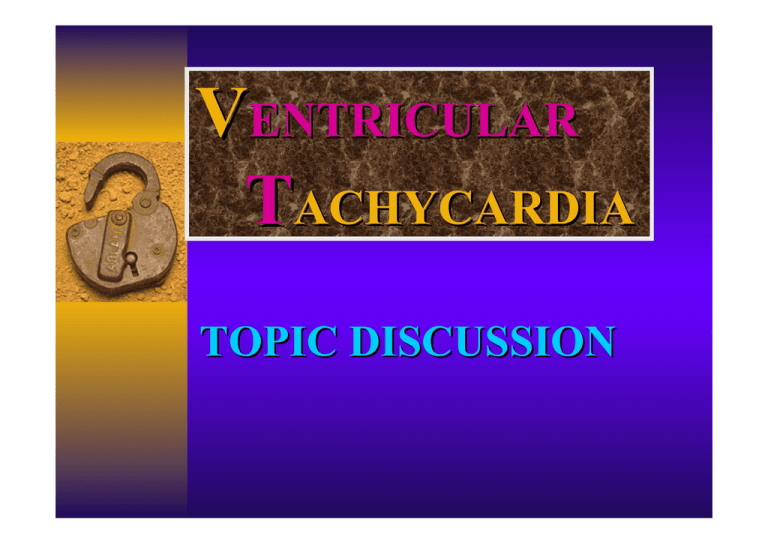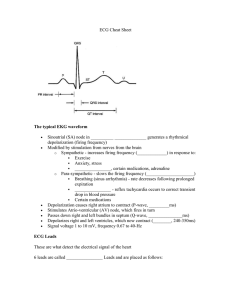Ventricular Tachycardia
advertisement

VENTRICULAR TACHYCARDIA TOPIC DISCUSSION VENTRICULAR TACHYCARDIA DEFINITION 3 or More ORS Complexes of Ventricular Origin Rate exceeding 100 bpm VENTRICULAR TACHYCARDIA INTRODUCTION VT & VF are Major Causes of SCD Ambulatory ECG Recordings at SCD Have Shown 50%-60% of Sustained Monomorphic VT as The Initial Event VENTRICULAR TACHYCARDIA KEY FEATURES SUSTAINED MONOMORPHIC VT: Most Common Mechanism Could be Re-Entry in Scarred Myocardium in Patients with Structural Heart Disease POLYMORPHIC VT: Caused by Abnormalities in Repolarization by Both Intrinsic or Transient Factors VENTRICULAR TACHYCARDIA CLASSIFICATION ECG MORPHOLOGY Monomorphic VS Polymorphic, BBB Pattern, Axis DURATION Sustained VS Nonsustained MECHANISM ETIOLOGY VENTRICULAR TACHYCARDIA CLINICAL PRESENTATION Quite varied (Asymptomatic, Syncope, Sudden Death) Duration, HR, Underlying Heart Disease, Other medical Conditions VENTRICULAR TACHYCARDIA CLINICAL SIGNIFICANCE Decreased CO 1. Rapid HR with Poor Ventricular Filling HR <150 bpm, well tolerated in short term; CHF occur in poor ventricular function patients HR >150 bpm, <200 bpm, tolerated with variability HR >200 bpm, virtually symptomatic in all patients VENTRICULAR TACHYCARDIA CLINICAL SIGNIFICANCE Decreased CO 2. Asynchrony between AV Conduction 3. Abnormal Sequence of Ventricular Activation 4. Loss of Atrial Contribution VENTRICULAR TACHYCARDIA CLINICAL SIGNIFICANCE Degenerative to VF SCD VENTRICULAR TACHYCARDIA DIFFERENTIAL DIAGNOSIS 1. SVT with Aberrant Intraventricular Conduction 2. BBB 3. Morphological Changes of QRS Secondary to Metabolic Derangement 4. Pacing VENTRICULAR TACHYCARDIA BRUGADA CRITERIA (D/D VT VS SVT with Aberrant Intraventricular Conduction) 1. Most Helpful with 99% Sensitivity and 96.5% Specificity Without Pre-Existing BBB 2. Stepwise Approach VENTRICULAR TACHYCARDIA 1ST ALGORITHM From Harrisons Internal Medicine, 15th Edi. VENTRICULAR TACHYCARDIA 2ND ALGORITHM (D/D VT VS Antidromic Tachycardia over An Accessory Pathway) VENTRICULAR TACHYCARDIA PATHOPHYSIOLOGY 1. Studies in experimental animals and intraoperative mapping in humans as well as pacings during VT 2. In post MI patients, VT was caused by a re-entrant mechanism 3. Areas of slow conduction have been identified as the substrate for re-entry. 4. In experimental MI, continuous electrical activity regularly and predictably bridged the entire diastolic interval could be demonstrated at the onset of VT by the use of electrodes VENTRICULAR TACHYCARDIA PATHOPHYSIOLOGY 5. These findings are corroborated by the anatomic characteristics of MI, which may show islands of relatively viable muscle alternating with areas of necrosis and later fibrosis 6. Such tissue may result in fragmentation of the propagating electromotive forces 7. Gardner et al. showed that induced slow conduction alone did not cause fragmented activity 8. Highly fractionated electrograms occurred only in preparations from chronic infarcts with interstitial fibrosis forming insulating boundaries between muscle bundles VENTRICULAR TACHYCARDIA PATHOPHYSIOLOGY 9. Another possibility is that there is a marked reduction in conduction velocity caused by a diminished intercellular coupling, which would be expected to cause high resistance to current flow between cells 10. The size of region necessary for occurrence of re-entry has not yet been fully established 11. Finally, a close correlation between the presence of continuous fractionated electrical activity and perpetuation of VT was demonstrated by Garan et al. VENTRICULAR TACHYCARDIA THERAPY Medical Treatment (No Hemodynamic Compromise) DCC (Unstable, Symptomatic) New Guidelines for VT in 2000 VENTRICULAR TACHYCARDIA THERAPY Medical Treatment 1. IV Procainamide, Xylocaine or Amiodarone 2. Reversible Cause Correction (eg.. Ischemia, Electrolyte Imbalance, Bradycardia) 3. Hypotension Treatment 4. Offending Agents Removal, and Antidotes if Necessary VENTRICULAR TACHYCARDIA THERAPY DCC 1. At Least 100 J DCC Initially in Stable Patient 2. 200 J DCC Synchronized in Unstable, Symptomatic VT 3. 200 J DCC Unsynchronized in Pulseless VT VENTRICULAR TACHYCARDIA PREVENTION & PROPHYLAXIS MEDICAL THERAPY Shift of Class I to Class III Maintenance Therapy in CAST Trial CURATIVE CATHETER-BASED THERAPIES SURGICAL PROCEDURES ICD -- Greatest Impact on Survival in SCD VENTRICULAR TACHYCARDIA PREVENTION & PROPHYLAXIS MEDICAL THERAPY ESVEM Trial It was Disappointing with Sotalol to be The Most Effective Drug EMIAT & CAMIAT Trial (Amiodarone post AMI) It Revealed A Decrease in Arrhythmia Deaths with No Survival Benefit VENTRICULAR TACHYCARDIA PREVENTION & PROPHYLAXIS MEDICAL THERAPY COMBINATION THERAPY With ICD in High Risk Patients in New Era VENTRICULAR TACHYCARDIA PREVENTION & PROPHYLAXIS MEDICAL THERAPY Calcium Channel Blocker is Effective in Some Idiopathic Monomorphic VTs: 1. VT from RVOT with LBBB 2. VT from LV Apex with RBBB 3. VT from Digoxin Toxicity VENTRICULAR TACHYCARDIA PREVENTION & PROPHYLAXIS CURATIVE CATHETER-BASED THERAPIES Radiofrequency Ablation is Used to Eliminate The Slow Conduction Pathway in A Re-entrant Circuit 50%-70% Successful Rate Progressively Developing Electrophysiologic study in ventricular tachycardia. (Re-entry type from previous MI) (a) A single extrastimulus (S2) after an 8-beat drive at 550ms cycle length (S1–S1) initiates sustained monomorphic ventricular tachycardia (VT). Note the presence of atrioventricular dissociation and the absence of a His potential before the QRS. (b) A burst of rapid ventricular pacing (RVP) is used to restore normal sinus rhythm (NSR). A, atrium; HRA, high right atrium; HBE, bundle of His; RVA, right Catheters are typically positioned in RA, Bundle of His region, ventricular apex; V, and the RV apex. The standard stimulation protocol may use ventricle. up to 3 ventricular extrastimuli delivered at 2 basic cycle lengths from 2 RV sites. VENTRICULAR TACHYCARDIA PREVENTION & PROPHYLAXIS ICD MADIT & AVID Trial (High Risk in EF <35% or Inducible Sustained VT at EPS) A Decided Advantage in ICD was Noted in Both Trials With 30%-50% Reductions in Mortality VENTRICULAR TACHYCARDIA CLINICAL PRESENTATION AND COURSE OF VT ISCHEMIC NON-ISCHEMIC TORSADES DE POINTS VENTRICULAR TACHYCARDIA CLINICAL PRESENTATION AND COURSE OF VT ISCHEMIC Altered Cellular Level Function Anatomic Scar Tissue Formation A Re-entrant Circuit With 2 Pathways Normal QT Interval VENTRICULAR TACHYCARDIA CLINICAL PRESENTATION AND COURSE OF VT ISCHEMIC Predictors: Larger Infarcts With Greater Resultant Impairment of LV Systolic Function LV Systolic Function is The Single Most Important Predictor of SCD due to Arrhythmia Revascularization Seemed to Decrease The Risk VENTRICULAR TACHYCARDIA CLINICAL PRESENTATION AND COURSE OF VT ISCHEMIC AIVR It is Seen Almost Exclusively in Ischemic Heart Disease, esp. During AMI or Reperfusion of An Occluded Territory (Enhanced Automaticity) It May be Seen in Digoxin Toxicity It is Rarely of Clinical Significance VENTRICULAR TACHYCARDIA CLINICAL PRESENTATION AND COURSE OF VT ISCHEMIC AIVR VENTRICULAR TACHYCARDIA CLINICAL PRESENTATION AND COURSE OF VT ISCHEMIC AIVR Therapy is Rarely Necessary Unless 1. Loss of AV Synchrony with Hemodynamic Change 2. R on T 3. Rapid Ventricular Rate or VF VENTRICULAR TACHYCARDIA CLINICAL PRESENTATION AND COURSE OF VT NON-ISCHEMIC 1. BB Re-entry, WPW Syndrome 2. Idiopathic VT 3. Congenital Long QT Syndrome 4. Genetically Associated VT 5. Idiopathic Polymorphic VT 6. Infection, Inflammation or Drug VT 7. Arrhythmogenic RV Dysplasia VENTRICULAR TACHYCARDIA CLINICAL PRESENTATION AND COURSE OF VT NON-ISCHEMIC BB Re-entry Common in DCM, Usually >= 200 BPM Typically LBBB, with less RBBB Most commonly With Right Bundle Antegrade Conduction Left Bundle Retrograde Conduction Confirmed by EPS Electrophysiologic findings in bundle branch re-entry. The tracings shown are surface ECG leads 1, aVF and V1, and intracardiac recordings from the high right atrium (HRA), the bundle of His (HBE) and the right ventricular apex (RVA). The surface leads show the typical pattern of left bundle branch block. The intracardiac recordings show atrioventricular dissociation and a His potential preceding each ventricular depolarization. A, atrium; His, His potential; RVA, right ventricular apex. VENTRICULAR TACHYCARDIA CLINICAL PRESENTATION AND COURSE OF VT NON-ISCHEMIC Idiopathic VT (VT From RVOT, VT From LV Apex) Otherwise Structurally Normal Hearts No Significant CAD No Family History of Arrhythmia or Sudden Death Normal Surface ECG Usually Responsive to Calcium Channel Blocker VENTRICULAR TACHYCARDIA CLINICAL PRESENTATION AND COURSE OF VT NON-ISCHEMIC Congenital Long QT Syndrome From Manual of Cardiovascular Medicine. By Steven P. Marso, Brian P. Griffin, Eric J. Topol From Manual of Cardiovascular Medicine. By Steven P. Marso, Brian P. Griffin, Eric J. Topol VENTRICULAR TACHYCARDIA CLINICAL PRESENTATION AND COURSE OF VT NON-ISCHEMIC Congenital Associated VT Muscular Dystrophies Duchenne’s Muscular Dystrophy Myotonic Dystrophy VENTRICULAR TACHYCARDIA CLINICAL PRESENTATION AND COURSE OF VT NON-ISCHEMIC Congenital Associated VT Muscular Dystrophies Frequent Defects in Conduction System Heart Block, BBB, and SCD due to VT VENTRICULAR TACHYCARDIA CLINICAL PRESENTATION AND COURSE OF VT NON-ISCHEMIC Idiopathic Polymorphic VT Structurally Normal Hearts Normal QT Interval VENTRICULAR TACHYCARDIA CLINICAL PRESENTATION AND COURSE OF VT NON-ISCHEMIC Idiopathic Polymorphic VT 1. Persistent ST Elevation 2. Exercise Reproducible Arrhythmias with Exercise and Responsive to β-Blocker 3. Polymorphic VT Triggered by VPCs with High SCD Incidence not Prevented by β-Blocker VENTRICULAR TACHYCARDIA CLINICAL PRESENTATION AND COURSE OF VT NON-ISCHEMIC Drug-Induced VT Both Polymorphic & Monomorphic Particularly True in Ischemic or Infarcted Hearts VENTRICULAR TACHYCARDIA CLINICAL PRESENTATION AND COURSE OF VT NON-ISCHEMIC Drug-Induced VT Phenothiazines, TCA, Digoxin, Epinephrine, Cocaine, Nicotine, Alcohol, and Glue Are Implicated With Monomorphic VT NSVT & Depressed LV Function Remained Risk Factors for SCD VENTRICULAR TACHYCARDIA CLINICAL PRESENTATION AND COURSE OF VT NON-ISCHEMIC Drug-Induced VT Torsades De Points Due to QT Prolongation Digoxin Can Propagate DAD to VT VENTRICULAR TACHYCARDIA CLINICAL PRESENTATION AND COURSE OF VT NON-ISCHEMIC DCM & HCM Increased Risk of VT to SCD VENTRICULAR TACHYCARDIA CLINICAL PRESENTATION AND COURSE OF VT NON-ISCHEMIC DCM Difficult to Predict Asymptomatic VT Are Common ICD in Life-Threatening Arrhythmia Ablation if BB Re-entry is The Mechanism VENTRICULAR TACHYCARDIA CLINICAL PRESENTATION AND COURSE OF VT NON-ISCHEMIC HCM HIGH RISK: Syncope, Family SCD History of First Degree, NSVT on Ambulatory ECG SVT, AF, and Ischemia Are Poorly Tolerated And May Lead to VT EPS May be Helpful in Stratifying Risk Amiodarone May be Beneficial Dual Chamber Pacing: Decrease Outflow Gradient VENTRICULAR TACHYCARDIA CLINICAL PRESENTATION AND COURSE OF VT NON-ISCHEMIC Structural Abnormalities Repaired TOF Often Originates in RVOT Cured by Ablation or Surgical Resection MVP (Quite Good Prognosis) Uncommonly Linked to SCD VENTRICULAR TACHYCARDIA CLINICAL PRESENTATION AND COURSE OF VT NON-ISCHEMIC Arrhythmogenic RV Dysplasia Cardiomyopathy Begins in RV and Often Progress to LV RV Dilatation with Resultant Poor Contractile Function RV Muscle Becomes Replaced by Adipose and Fibrous Tissue VENTRICULAR TACHYCARDIA CLINICAL PRESENTATION AND COURSE OF VT NON-ISCHEMIC Arrhythmogenic RV Dysplasia Re-entrant Type (Scarring & Late Potentials) With LBBB Morphology Often Inversion T Over Right Chest Leads Slurred Terminal Portion of QRS Complex (Epsilon Wave) A ventricular tachycardia with a left bundle pattern and superior axis from the same patient. LAO, left anterior oblique. VENTRICULAR TACHYCARDIA CLINICAL PRESENTATION AND COURSE OF VT NON-ISCHEMIC Arrhythmogenic RV Dysplasia VENTRICULAR TACHYCARDIA CLINICAL PRESENTATION AND COURSE OF VT NON-ISCHEMIC Arrhythmogenic RV Dysplasia The Risk of VT Correlate With The Extent of Myocardial Involvement Therapy With Sotalol & Amiodarone May be Successful The Effect of Catheter Ablation is Temporizing ICD is The Only Reliable Therapy in SCD VENTRICULAR TACHYCARDIA CLINICAL PRESENTATION AND COURSE OF VT NON-ISCHEMIC Inflammatory or Infectious Conditions Sarcoidosis Heart Block, VT or VF Amiodarone or Sotalol Are Most Efficacious ICD May be Necessary VENTRICULAR TACHYCARDIA CLINICAL PRESENTATION AND COURSE OF VT NON-ISCHEMIC Inflammatory or Infectious Conditions Acute Myocarditis Monomorphic & Polymorphic VT Anti-arrhythmic & Anti-inflammatory Therapy Are Generally Combined VENTRICULAR TACHYCARDIA CLINICAL PRESENTATION AND COURSE OF VT NON-ISCHEMIC Inflammatory or Infectious Conditions Chagas’ Disease (Trypanosoma Cruzi) Cardiomyopathy in South & Central USA VT & Other Arrhythmias Due to Conduction System Involvement (Pacemaker or ICD) Antiparasitic, CHF, Anti-arrhythmic Treatment VENTRICULAR TACHYCARDIA CLINICAL PRESENTATION AND COURSE OF VT TORSADES DE POINTES Delayed Myocardial Repolarization, Most Often Prolonged QT Interval The Duration is Typically Brief (< 20 sec), But Also May Degenerate to VF Irregular Ventricular Rate in Excess of 200 bpm Polymorphic Structure With An Undulating Twist (QRS) Around An Isoelectrical Axis VENTRICULAR TACHYCARDIA CLINICAL PRESENTATION AND COURSE OF VT TORSADES DE POINTES VENTRICULAR TACHYCARDIA CLINICAL PRESENTATION AND COURSE OF VT TORSADES DE POINTES Congenital Acquired VENTRICULAR TACHYCARDIA CLINICAL PRESENTATION AND COURSE OF VT TORSADES DE POINTES Congenital VENTRICULAR TACHYCARDIA CLINICAL PRESENTATION AND COURSE OF VT TORSADES DE POINTES Acquired Drug Induced (Most Often) Electrolyte Abnormalities Hypothyroidism Cerebrovascular Events MI or Ischemia VENTRICULAR TACHYCARDIA CLINICAL PRESENTATION AND COURSE OF VT TORSADES DE POINTES Acquired Starvation Diets Organophosphate Poisoning Myocarditis Severe CHF MVP VENTRICULAR TACHYCARDIA CLINICAL PRESENTATION AND COURSE OF VT TORSADES DE POINTES Drug Induced (Most Often) Class IA Drugs (Most Often) Class III Drugs (Less Often) & Ibutilide Phenothiazines, Haloperidol, TCA Antibiotics (Macrolides & Antihistamines Combination, TMP/SMX) Antihistamines Combination With Azoles VENTRICULAR TACHYCARDIA CLINICAL PRESENTATION AND COURSE OF VT TORSADES DE POINTES Bradycardia In Patients With Prolonged QT Ionic Contrast Media Promotility Agents Cisapride VENTRICULAR TACHYCARDIA CLINICAL PRESENTATION AND COURSE OF VT TORSADES DE POINTES Electrolyte Abnormalities Hypokalemia (Most Reliably Linked) Hypomagnesemia Hypocalemia (Rare) VENTRICULAR TACHYCARDIA CLINICAL PRESENTATION AND COURSE OF VT TORSADES DE POINTES Cerebrovascular Events SAH (Most Notably) ICH (Transient for Weeks) VENTRICULAR TACHYCARDIA CLINICAL PRESENTATION AND COURSE OF VT TORSADES DE POINTES Treatment Prompt DCC in Sustained, Hemodynamic Compromise Situation (50J - 100J, up to 360J) Correction of Electrolytes (K>4; Mg>2; Ca) MgSO4: 1-2 gm Bolus With All 2-4 gm in 10-15 Minutes Isoproterenol IVD or TVP in Bradycardia; Occasionally ß-Blocker, Lydocaine






